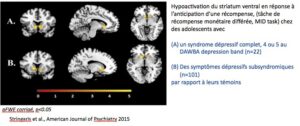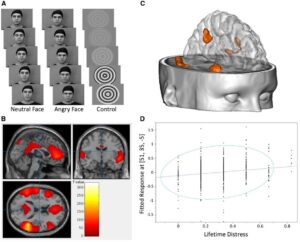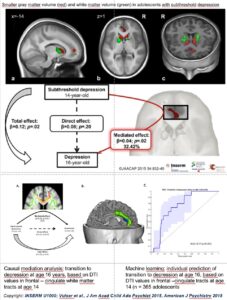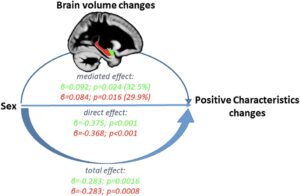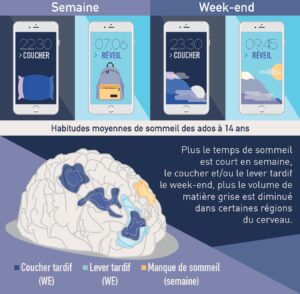Our analyses highlight the vulnerability of neuro-emotional systems from the beginning of adolescence, and all indications are that brain development may be organised around early features that will favour the risk of recurrent depression.
This research is carried out within the framework of the first worldwide multidisciplinary cohort of European adolescents followed from 14 to 23 years of age (2000 adolescents, 3 waves of evaluations) https://imagen-project.org/
Particular attention is being paid to the study of interactions with life events during transition periods, and their contribution to individual vulnerability.
Multimodal imaging of brain development in adolescents and young adults explores the hypothesis that key periods of brain maturation correspond to phases of transition and vulnerability to psychopathological risk : https://www.neuron-eranet.eu/_media/ADORe_summary.pdf
Precursors of depressive states have been detected by the ERL INSERM collaborators in adolescents followed between 14 and 16 years of age: difficulties in emotional regulation during adolescence often lead to fears of the onset of a mood disorder.
- Funtional precursors :
– In « healthy » adolescents at age 14, decreased activation of the ventral striatum preceded a subdepressive state or major depression at age 16 (© American Journal of Psychiatry 2015) :
– Stressful life events may – alter the fMRI responses of anger-activated regions, and – mediate a risk of diagnosis of major depression two years later.
Figure: relationship between regional activation during viewing of faces expressing negative emotion and psychological distress experienced during past life events (© Gollier-Briant et al., Social Cognitive and Affective Neuroscience 2016) :
2. Structured precursors :
3. Emotional regulation in adolescence, in girls and boys :
Between the ages of 14 and 16, volume variations in limbic regions (limbic amygdala and hippocampus) mediated some of the personality changes between girls and boys (©Bezivin, Neuroimage 2020) :
- Sleep patterns in adolescence :
At age 14, mismatch in sleep patterns between weekends and weekdays correlated with volume decreases in medial prefrontal and anterior cingulate regions, and worsening academic performance (Urrila et al., Scientific Reports 2017) :
|
5. Implications : This information highlights the vulnerability of neuro-emotional systems from early adolescence. They contribute to rationalise the age of protection of the most vulnerable adolescents . (http://www.assemblee-nationale.fr/dyn/15/dossiers/lutte_violences_sexuelles_sexistes) Towards new interventions for the prevention of severe depressive states (https://www.neuron-eranet.eu/_media/ADORe_summary.pdf) The main objective of the international consortium is to develop innovative preventive strategies to target behaviours and symptoms that, when present in adolescence, are precursors of severe depressive states in adulthood.
|
